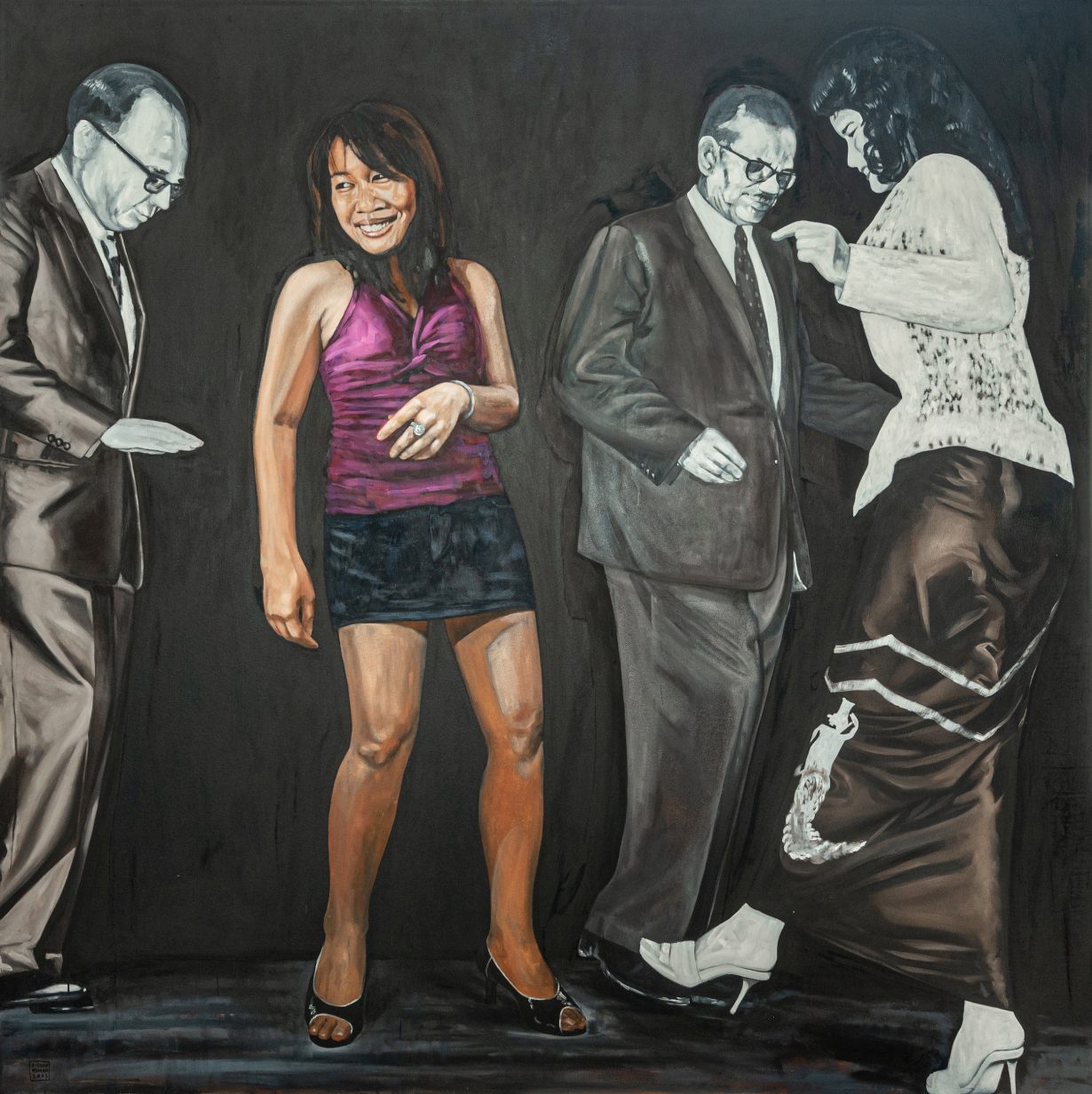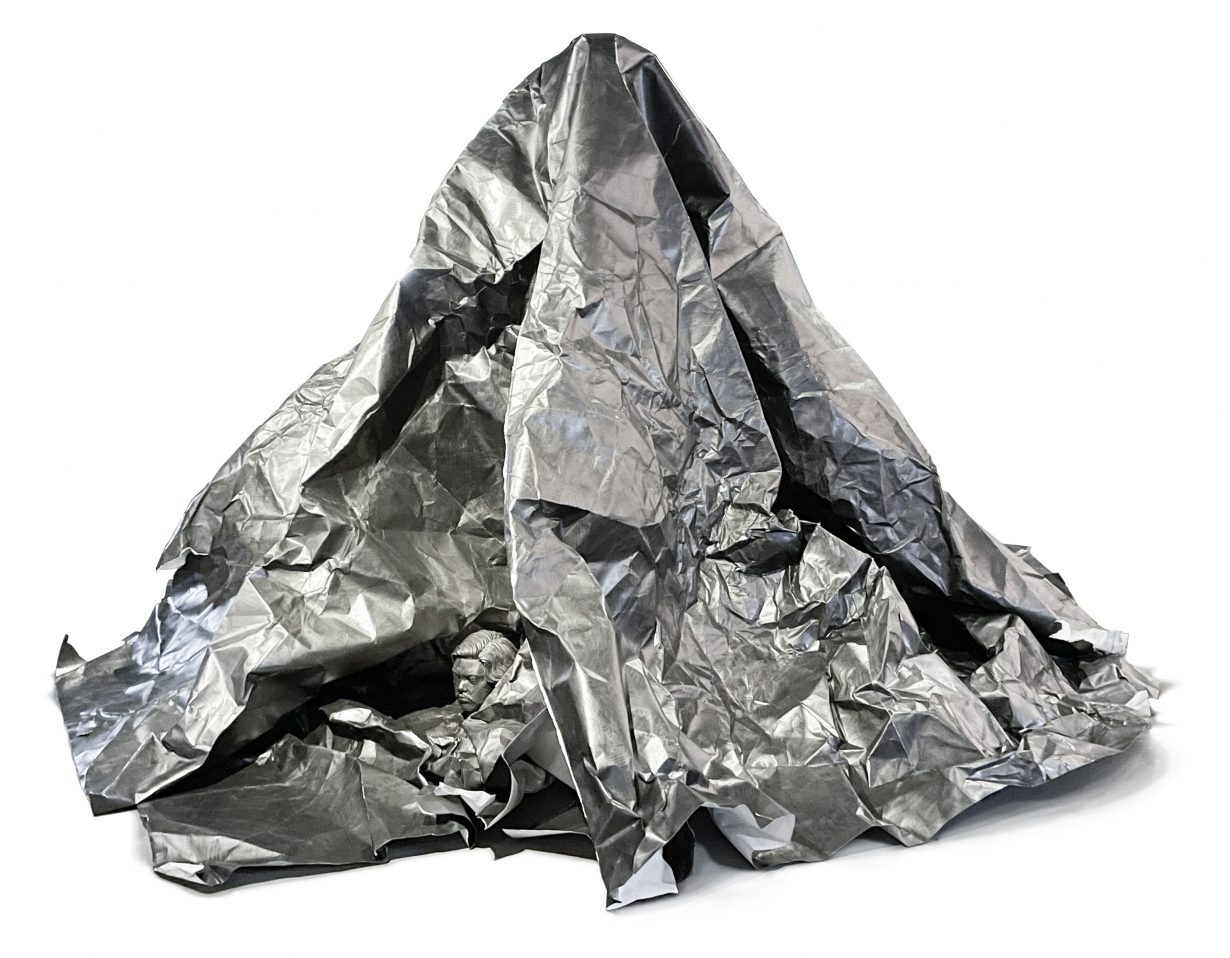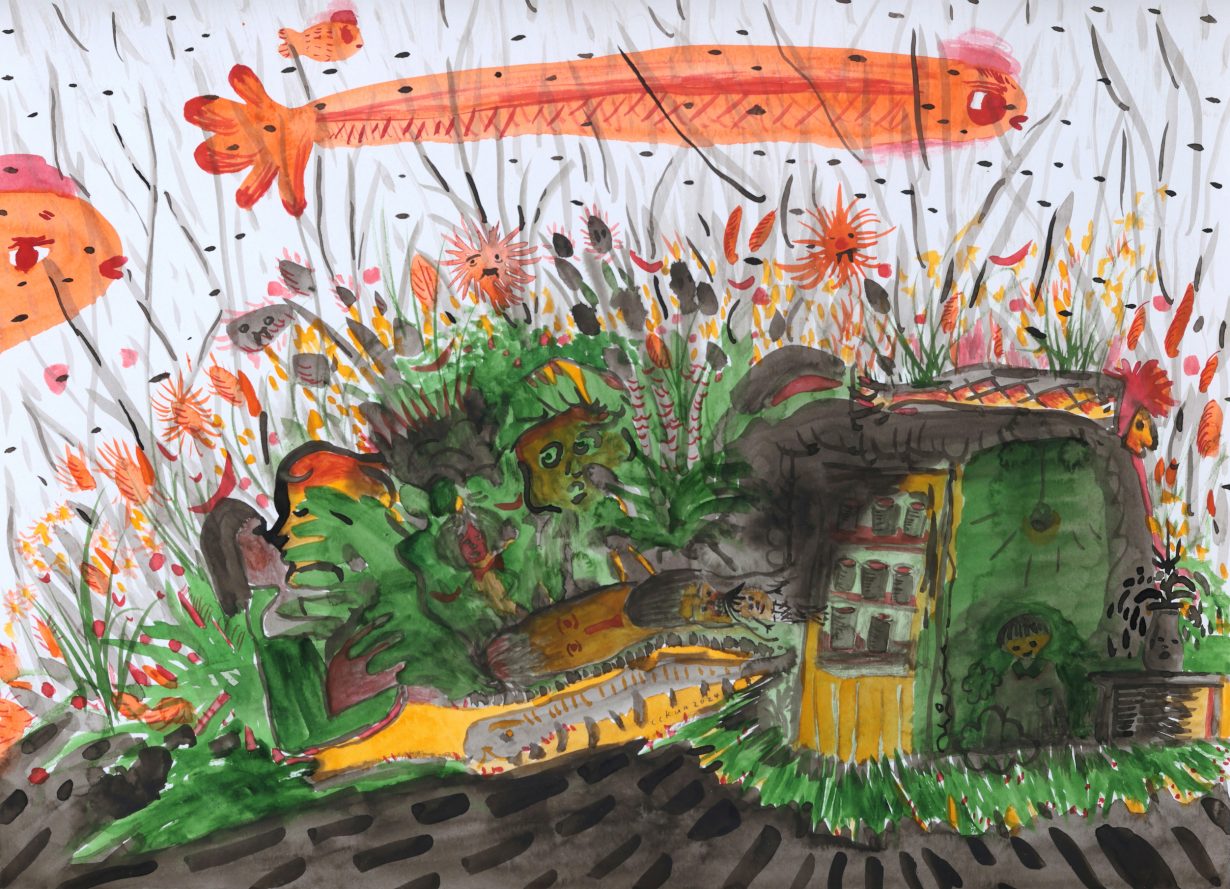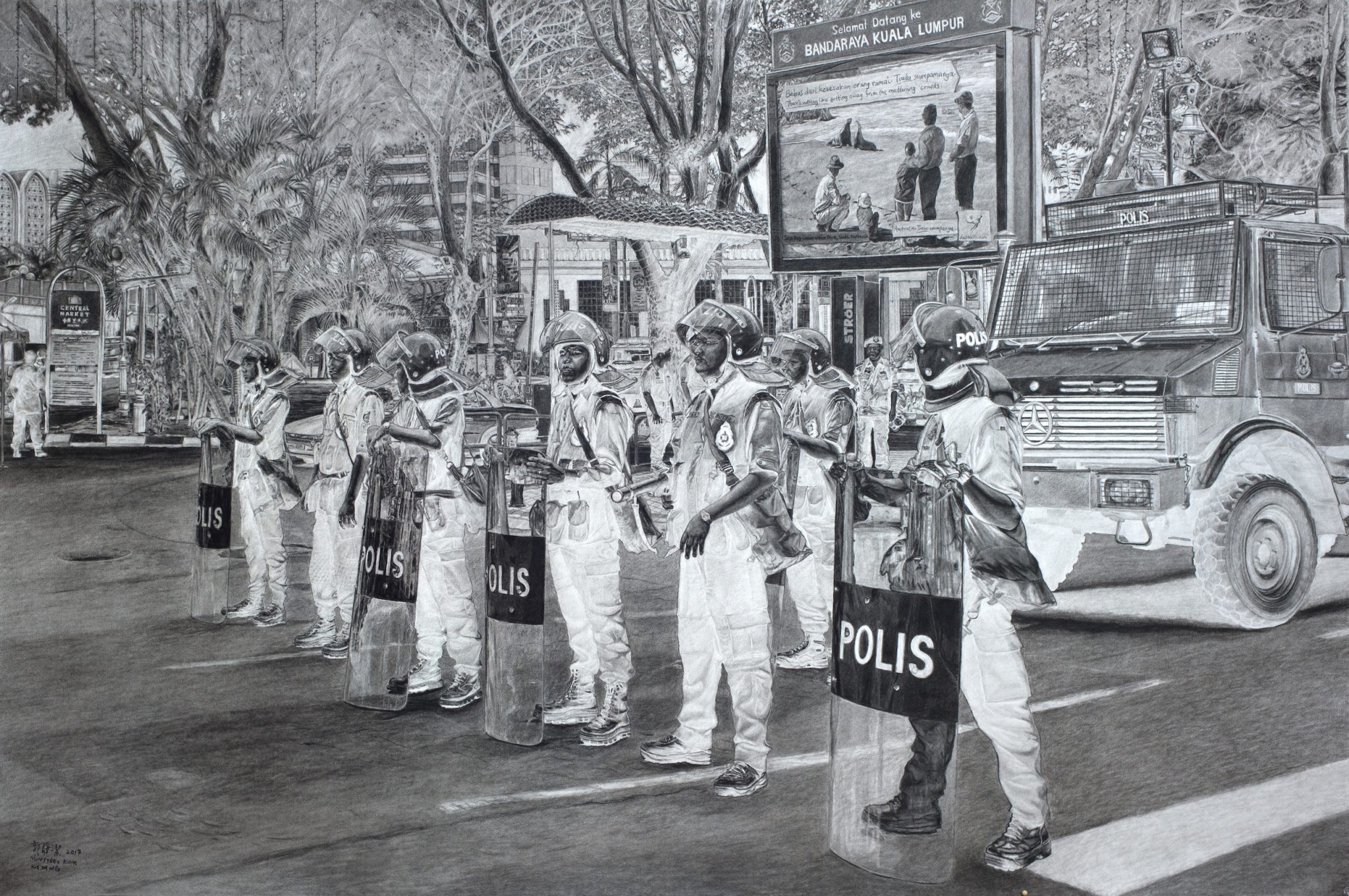When it comes to questions about the role of private collections in Malaysia, where public funding for art is scarce, the answers aren’t all black and white
At its peak, the popular Bersih movement in Malaysia, which has been agitating for cleaner and fairer elections in the country for nearly two decades, saw more than half a million people taking to the streets of Kuala Lumpur in 2015. The Bersih campaign organised four rallies between 2007 and 2011, eventually galvanising Malaysians to vote out the United Malays National Organisation (UMNO) in the 2018 general election, ending the party’s six decades in power. Malaysian artist Minstrel Kuik’s 2017 charcoal drawing Selamat Datang Ke Bandaraya Kuala Lumpur (Welcome to the city of Kuala Lumpur) depicts a scene from a Bersih rally near KL’s Central Market. The artist had taken a photograph and made the drawing from that source image. A row of riot police officers lean on their shields, using them more for support than as a protective device. Even the police are tired. It’s an image not just of law enforcement but suggestive of a general sense of exhaustion resulting from the messiness of Malaysian politics. After all, UMNO, after a series of twists and turns, is now back in government following 2022’s inconclusive election, when Anwar Ibrahim, now prime minister, formed an alliance with the party.
Kuik’s drawing is one of several politically charged works in a recently concluded exhibition in Kuala Lumpur, Not Just in Black and White, which highlighted 76 works from the private collection of retired plastic surgeon Steve Wong. Displayed at GDP Campus, an exhibition space run by the eponymous architecture firm, and curated by cultural agency Rogue Art in conjunction with Wong, the show’s premise – basically, ‘these are all works in black and white’ – doesn’t sound like the most exciting proposition, but the exhibition somehow ended up being a pleasurable and informative journey through Malaysian contemporary art from the 1990s onwards, through the eyes of a politically engaged arts patron.
Wong favours bold figurative paintings that offer sociopolitical commentary, and a section of the show focused specifically on Malaysian history and politics. Yee I-Lann’s digital print of a herd of buffaloes trampling over orange traffic cones (the only pops of colour in a dark-hued work) can be seen as emblematic of the Bersih movement: a disgruntled citizenry charging through temporary obstacles (Kerbau, 2007). Elsewhere, I enjoyed Ahmad Fuad Osman’s painting of Malaysia’s first prime minister, Tunku Abdul Rahman (Recollections of Long Lost Memories #4, 2007–08). We see Abdul Rahman, known as a great dancer, jiving in his suit with a ‘Joget girl’, a female dancer dressed in the traditional sarong kebaya – an elegant, close-fitting long-sleeved top and long skirt. Inserted into the middle of this black-and-white scene is a female figure painted in colour, dressed in a skimpy tank top, short skirt and high heels, who alludes to a more contemporary (and seedy) nightlife, one that has been disavowed under the stricter Islamisation of present-day politics.
The figurative works on display were a celebratory showcase of Malaysia’s diversity. These included Ahmad Zakii Anwar’s photorealistic charcoal drawings of three Indian Hindus, with their bare and powerful torsos rendered in painstaking detail (Devotees, 2008). Self-portraits also allowed artists to explore different identities. Female artist Nadiah Bamadhaj depicts herself topless and wearing a songkok, a traditional hat donned by Muslim men in Southeast Asia (Landlocked, 2008).

Meanwhile, Malaysia’s rich landscapes were portrayed in paintings informed by traditions drawn from the country’s multicultural heritage. Inspired by shanshui, a style of classical Chinese ink painting, Wong Perng Fey’s 12 heroic vistas of the jagged ridges at the peak of Borneo’s Mount Kinabalu were individually drawn alongside clouds that shifted their position slightly in each depiction, overall creating the impression of a time-lapse series (Kinabalu 1–12, 2003).
There was also robust evidence of various material investigations. W. Rajaie utilises soil to create unearthly textures in his mixed media work that resemble moonrock (Block, 2021). Paul Nickson Atia’s geometric black and beige patterns formed part of a smattering of abstract works. Starting with a ruler-drawn grid, the artist then paints strokes of different thicknesses along each line using Chinese ink; the result is like a glitched version of Sarawak basketry (Obsession; O, Perpetual, 2019).
Although the exhibition, as curator Beverly Yong writes in the catalogue essay, ‘makes no claim to describe a developmental history’, it is nonetheless a survey of the country’s contemporary art over the last 30 years as seen through an individual’s collecting choices. The quality and purposefulness of the collection also highlights some broad differences between the contemporary art ecologies in Singapore and Malaysia. In Singapore, with its established system of issuing artist grants, as well as institutions with deep pockets, the state is the most influential player in the art scene. In Malaysia, collectors with even deeper pockets are king, comparable to other places where art-related infrastructure is less developed, and state institutions have limited budgets. Private collections tell far more compelling and diverse stories than those found in national museums.

This year alone, there have been two other major exhibitions mounted by prominent private collectors showcasing art from the past three decades. In August, landscape architect Ng Sek San staged Strategies of Dissent, which featured 70 works exploring the art of protest and resistance from the 1990s to the present. Meanwhile, in June, 100 works owned by lawyer Pakhruddin Sulaiman were presented in Tubuh. Produced during the 1990s and early 2000s, these works deal with the aftermath of Reformasi, a movement initiated by Anwar Ibrahim in 1998, when he was sacked as deputy prime minister, which launched a massive mobilisation against former mentor Mahathir Mohamad’s government demanding reform.
Interestingly, what the shows have in common is a critical engagement with the unfolding turmoil in Malaysian politics from Mahathir-era authoritarianism and Najib Razak’s scandal-plagued administration to former political exile Anwar being elected as prime minister. The works on display speak of the progressive views of their owners and are a way for them to express their political opinions. Like artists, collectors can challenge the cultural and social order of the day.
My trip to Kuala Lumpur ended with a visit to Ilham, a privately funded art space that operates as a free public gallery with a regular roster of exhibitions, events and educational outreach programmes – a very different model of support compared to the show of treasures taken from a collector’s storeroom. Over the past nine years, Ilham has established itself as the most important art space in Kuala Lumpur, rolling out a well-researched programme that explores modern and contemporary art in Malaysia and Southeast Asia more generally, and collaborating with regional partners like Singapore Art Museum, Para Site Hong Kong and MAIIAM Contemporary Art Museum in Thailand. The gallery is located within the Central Business District (CBD), housed in the swanky 60-storey Ilham Tower owned by the family of former finance minister Daim Zainuddin. In December 2023, Ilham Tower was seized by Malaysia’s antigraft agency because of an ongoing probe into controversial transactions by corporate entities previously controlled by UMNO. Despite the controversy, the building – together with Ilham, which occupies the third and fifth levels – seemed to be operating as usual when I visited. Art philanthropy, like Malaysian politics, can be opaque and messy.

The current show, Titik Garis Bentuk: Drawing as Practice, features over 20 contemporary artists from across Malaysia who use drawing in various forms. There was some overlap with Not Just in Black and White, as many artists in both shows used charcoal – but overall the Ilham exhibition embraced a greater diversity of moods, themes and media. For a drawing show, it included videoworks, videogames and sculptures that utilised drawing in the process of their creation.
Besides social themes, close attention was given to personal experiences, such as the monument to grief in Hasanul Isyraf Idris’s sculpture Quarry (2022), in which the artist coloured in a huge piece of paper with God knows how many pieces of graphite sticks so that the paper turned completely black, semi-hardened and able to stand up. Manipulated into the shape of a black mountain, the sculptural material’s surface possessed a metallic, oillike sheen. The work was inspired by the artist’s loss of three family members during the COVID 19 pandemic, and while driving back to his home-town of Perak to attend the funerals, he passed by a huge granite hill where his late father used to work as a security guard.
There was also strong representation of women and emerging practices, such as the doodly watercolour works of CC Kua that imbue everyday life with woozy, extraordinary elements that work like dream logic. New Home (2024) features a tiny house amid tall grasses, with the human inhabitants sliding out of it horizontally like worms, while in the sky floats a long red fish. Her landscape not only maps the natural environment but a more mysterious, interior one.
Overall, I don’t think any art lover could find it in their heart to oppose Ilham, despite its association with potentially shady sources of funding. In a city where public financing for art is scarce, such private initiatives plug an important gap in the cultural scene. Given this, morality, as American writer and historian Henry Adams said, can be a ‘private and costly luxury’. Ilham should therefore be (cautiously) welcomed as a serious platform for contemporary art practices.
